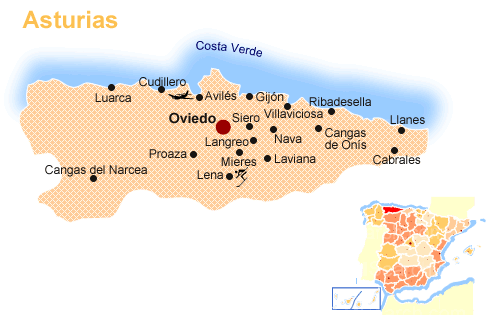F1 Holiday part 1: Oviedo

As the three-week holiday in Formula One has started, it's the perfect time for the F1 fans to jump on the plane and leave for a sunny destination themselfs. F1 Technical will give you some idea's where to go, all F1 related of course.
The Principality of Asturias in Spain is a diverse and rugged country, defined by a wonderfully romantic coastline, awesome mountains and the greenest countryside found anywhere in Spain. History is ever present, often reflected in the beautiful Asturian churches. There is one city in Asturias that has become very popular thanks to one of it's inhabitants: Oviedo. Oviedo is the birthplace of World Champion Fernando Alonso.

Oviedo is the capital city of the Principality of Asturias in northern Spain. It is also the name of the municipality which contains the city.
Oviedo is the capital of the Principality of Asturias and is the administrative and commercial centre of the region. The city also hosts the annual Prince of Asturias Awards (won by Fernando Alonso in 2005). The Oviedo University's International Campus also attracts a handful of foreign scholars.
History
Little could the monks Máximo and Fromestano, founders of the city in 761, have suspected that their choice of a hill in the centre of Asturias would give rise to an urban, commercial, ecclesiastic and military life that has lasted for more than 1200 years. That first settlement was to be soon completed with the construction of a small church dedicated to Saint Vicente.
King Fruela I of Asturias, the fourth of the Asturian monarchs, was the first decided promoter of the city as may be witnessed by his construction of both a palace and a nearby church. Nevertheless, Oviedo owes to Alfonso II, The Chaste (791-842) its establishment as a capital city and ruling seat as a result of the moving of the court from Pravia and the creation of the Pilgrim’s Route to Santiago de Compostela, a major event in the history of Oviedo, a church dedicated to The Saviour, the Cathedral of San Salvador, and a royal palace formed the nucleus and motive power of Oviedo.
During this period the city became the centre of an original and unique architectural expression, inheritor of Visigothic, Roman and Nordic traditions, which was to reach its high point during the reign of Ramiro I of Asturias. Ramiro I sponsored many unique construction projects which, to this day, remain a signature of Oviedo.
The moving of the royal court to León, after the death of Alfonso III, The Great, links the life of the city to the relics preserved in its cathedral and the passing of pilgrims that visit El Salvador, and continue on their way to Santiago de Compostela. The following centuries (XII-XVI) witness the development of the medieval city, the outlines of which are still preserved today, the construction of the city walls, a devastating fire which took place on Christmas Eve in 1521, and the formidable aqueduct works, Los Pilares, constructed in order to provide the city with water throughout the XVI century.
The foundation of the Arts College (University of Oviedo) by Fernando de Valdés Salas, at the beginning of the 17th century, opened Oviedo to a progressive urban expansion. Further impulse was in the 18th century by the city nobility and the construction of remarkable palaces; in the 19th century by industrial growth and the suburban development of Uría Street; and finally in the 20th century by administrative and commercial development.
Oviedo, a town of architecture and culture
Oviedo counts a lot of curiosities such as the Cathedral of San Salvador, Cámara Santa de Oviedo, La Foncalada and Basilica of San Julián de los Prados. Some of these buildings are part of the UNESCO World Heritage.

There are also many museums in Oviedo and as earlier reported this week, there will be one more in the near future. (http://www.f1technical.net/news/3695)
This is only a brief introduction of the city of Oviedo, the city of Fernando Alonso. Of course there is much more to see at Oviedo and the other cities in Asturias, but we'll let you discover that on your own.



